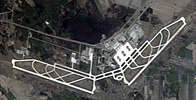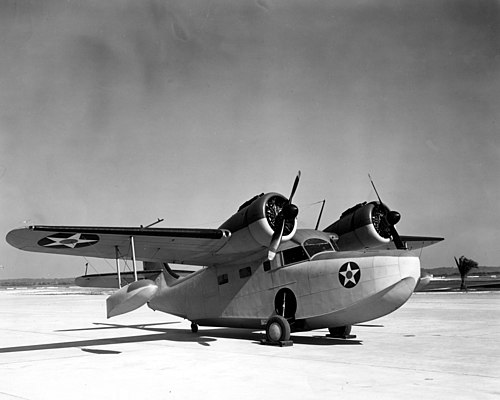Portal:Aviation
| Main page | Categories & Main topics |
|
Tasks and Projects |
The Aviation Portal

Aviation includes the activities surrounding mechanical flight and the aircraft industry. Aircraft includes fixed-wing and rotary-wing types, morphable wings, wing-less lifting bodies, as well as lighter-than-air craft such as hot air balloons and airships.
Aviation began in the 18th century with the development of the hot air balloon, an apparatus capable of atmospheric displacement through buoyancy. Some of the most significant advancements in aviation technology came with the controlled gliding flying of Otto Lilienthal in 1896; then a large step in significance came with the construction of the first powered airplane by the Wright brothers in the early 1900s. Since that time, aviation has been technologically revolutionized by the introduction of the jet which permitted a major form of transport throughout the world. (Full article...)
Selected article
The airport's location and lack of transport links, as well as Montreal's economic decline relative to Toronto, made it unpopular with airlines. Eventually relegated to the simple role of a cargo airport, Mirabel became an embarrassment widely regarded in Canada as being a boondoggle, or a "white elephant," and one of the best examples of a failed megaproject. (Full article...)
Selected image
Did you know
...that sailplane winglets were first successfully implemented by American inventor Peter Masak?

... that Samuel Frederick Henry Thompson, a British flying ace of World War I, scored 30 kills in five months of service and won both the DFC and MC?
General images -
In the news
- May 29: Austrian Airlines cancels Moscow-bound flight after Russia refuses a reroute outside Belarusian airspace
- August 8: Passenger flight crashes upon landing at Calicut airport in India
- June 4: Power firm helicopter strikes cables, crashes near Fairfield, California
- January 29: Former basketball player Kobe Bryant dies in helicopter crash, aged 41
- January 13: Iran admits downing Ukrainian jet, cites 'human error'
- January 10: Fire erupts in parking structure at Sola Airport, Norway
- October 27: US announces restrictions on flying to Cuba
- October 3: World War II era plane crashes in Connecticut, US, killing at least seven
- September 10: Nevada prop plane crash near Las Vegas leaves two dead, three injured
- August 6: French inventor Franky Zapata successfully crosses English Channel on jet-powered hoverboard
Related portals
Associated Wikimedia
The following Wikimedia Foundation sister projects provide more on this subject:
-
Commons
Free media repository -
Wikibooks
Free textbooks and manuals -
Wikidata
Free knowledge base -
Wikinews
Free-content news -
Wikiquote
Collection of quotations -
Wikisource
Free-content library -
Wikiversity
Free learning tools -
Wikivoyage
Free travel guide -
Wiktionary
Dictionary and thesaurus
Selected biography
Selected Aircraft

The Airbus A340 is a long-range four-engined widebody commercial passenger airplane manufactured by Airbus. The latest variants (-600 & A340E) competed with Boeing's 777 series of aircraft on long-haul and ultra long-haul routes, but it has since been succeeded by the Airbus A350.
The A340-600 flies 380 passengers in a three-class cabin layout (419 in 2 class) over 7,500 nautical miles (13,900 km). It provides similar passenger capacity to a 747 but with twice the cargo volume, and at lower trip and seat costs.
The A340-600 is more than 10 m longer than a basic -300, making it the second longest airliner in the world, more than four meters longer than a Boeing 747-400.
- Span: 63.45 m (208 ft 2 in)
- Length: 75.30 m n(246 ft 11 in)
- Height: 17.30 m (56 ft 9 in)
- Engines: four 56,000 lbf (249 kN) thrust Rolls-Royce Trent 556 turbofans
- Cruising Speed: Mach 0.83 (885 km/h, 550 mph)
- First Flight: October 25, 1991
Today in Aviation
- 2006 – Johnnie Checketts, New Zealand fighter pilot, dies (b. 1912). Wing Commander John "Johnny" Milne Checketts DSO DFC (20 February 1912 – 23 April 2006) was a World War II Flying ace who was credited with 14.5 kills. He was awarded the US Silver Star in 1944 and the Polish Cross of Valour in 1945.
- 2005 – First flight of the Cessna Citation Mustang
- 1996 – First flight of the Extra EA-400
- 1994 – Airbus delivers the first of 25 A300-600F dedicated freighters to the specialized package carrier, FedEx. This all-cargo version can carry up to a maximum payload of 120,855 lb over a range of 1,900 nautical miles.
- 1988 – The U.S. government's ban on smoking on flights of two hours or less goes into effect. "No Smoking" signs remain lit on 80% of domestic airline flights. Flight attendants are to be armed with gum and candy for those in anguish.
- 1988 – Kanellos Kanellopoulos recreates the mythical flight of Daedalus by flying a pedal-powered aircraft, the MIT Daedalus from Crete to Santorini, covering the 119 km (74 miles) in 3 hours 54 min.
- 1971 – A USAF General Dynamics F-111E, 67-0117, c/n A1-162/E-3, out of Edwards AFB, California, crashes in a rocky area of the Mojave Desert 12 miles S of Death Valley National Monument during test flight, both crew, pilot Maj. James W. Hurt, 34, of Indianapolis, Indiana, and WSO Maj. Robert J. Furman, 31, of New York City, killed when parachute on escape module fails to open until just before ground impact. Both bodies were inside the escape module when it is found on Saturday, 24 April. Aircraft experienced trouble at 6,000 feet. This was the 18th crash of the type since entering service and the second fatal accident this year when the module chute failed to properly deploy. All F-111s are grounded on Thursday 30 April after it is determined that the recovery chute compartment door failed to separate making crew escape impossible. This was the sixth grounding order for the type since it entered operation. The grounding order was lifted on 8 June 1971 during which time the panel that failed in this accident had been replaced.
- 1966 – American aircraft encounter MiG fighters in large numbers over North Vietnam.
- 1965 – The first production C-141A Starlifter cargo aircraft is delivered to the U.S. Air Force' Military Airlift Command.
- 1959 – In the 1959 Air Charter Turkey crash, an Avro Super Trader IV crashes on Mount Süphan, Turkey; all 12 crew on board die.
- 1956 – First flight of the Douglas C-133 Cargomaster.
- 1950 – A prototype SNCASO 4000, France's first jet bomber design, F-WBBL, rolled out 5 March 1950, suffers undercarriage collapse during taxiing trials causing extensive damage. Complex gear design proves too fragile for aircraft weight. With repairs and strengthened gear, the bomber makes its first and only flight on 15 March 1951 but design is found to be underpowered and unstable and never again takes to the air.
- 1945 – A U.S. Army Air Force (USAAF) Boeing B-17G Flying Fortress 43-38856, coded 'GD-M', of the 381st Bombardment Group (Heavy), crashes on the east facing slope of North Barrule in the Isle of Man killing 31 US service personnel (including ground crew) en route to Belfast for memorial service for President Roosevelt.
- 1945 – The United States Navy puts its first radar-guided bomb, the SWOD-9 "Bat" into use, dropping it from Consolidated PB4Y Liberators on Japanese shipping in Balikpapan Harbour.
- 1943 – Seventh Air Force B-24 Liberators bomb Tarawa Atoll.
- 1942 – U.S. Navy Vought SB2U-2 Vindicator, BuNo 1363,[120] of VS-71, assigned to the USS Wasp, but flown ashore to clear deckspace for Spitfires bound for Malta, crashes in peat bog near Invergordon, Scotland, killing Ens. Jackson and Aviation Machinist's Mate Atchison. Atchison's body recovered, but squadron diary records that Jackson's body and bulk of airframe were buried too deeply, so remains and wreckage were covered over.
- 1941 – No. 405 (Bomber) Squadron was formed in England.
- 1941 – German Junkers Ju 87 dive bombers sink the Greek battleships Kilkis and Lemnos off Salamis Island, Greece, during the German invasion of Greece.
- 1939 – The U.S. Civil Aeronautics Authority raises the eligibility age for obtaining a private pilot license to 18 years from the previous 16 years.
- 1919 – The North Sea Aerial Navigation Company begins a passenger run between Leeds and Houndslow in ex-military Blackburn RT.1s.
- 1918 – Lt. Paul Baer shoots down his fifth aircraft, becoming the first ace of the American Expeditionary Force.
- 1915 – Patrick Nieson Lynch Bellinger, American pioneering US Naval aviator, climbed a Burgess-Dunne AH-10 to 10,000 feet in 1:19
- 1911 - Yoshitoshi Tokugawa set a Japanese record with a Blériot, flying 48 miles in 1:09:30
References
- Shortcuts to this page: Portal:Airplanes • P:AVIA





















































